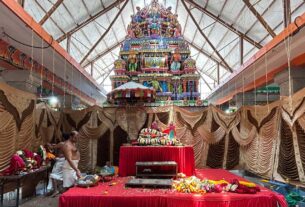Despite the declining population growth rate of the Jain community in the country, there has been a rise in the number of youths attaining sainthood, therefore killing economic growth in many ways.
By Surbhi Shah
Drums rolled, people danced, and a 13-year-old wore her best outfit and jewellery for one last time before being wrapped in a white cotton cloth and having her hair plucked out one by one. Her name will be changed from Riddhi Furiya and she will just be known as a sadhvi (female monk) after her diksha ceremony (attaining sainthood) on Wednesday.
“Her parents are proud of her. There is no age limit for attaining diksha,” said Jigna, Riddhi’s relative.
The practice of taking diksha or sainthood in Jainism is common and has been growing in the recent years with many youngsters opting for it.
Mukesh Shah lives in Mumbai and has two daughters who recently graduated from college and decided to take diksha. “God has said that the best age to take diksha is at 8 years old as the child is a blank slate and anything can be written on it. We all learn things at a small age. It is easy to fill an empty box then to refill after removing the contents of an already filled box,” Shah said.
“To achieve moksha (heaven), diksha is necessary,” he added.
The population growth rate of the community has been decreasing over the years, with 23 per cent increase from 1991 to 2001 to only 4.7 per cent increase from 2001 to 2011.
Though a minority, the community’s impact on India’s economy remains high, with most members having a business background. The National Family and Health Survey, 2015-16 showed that Jains are the richest community in India, with more than 70 per cent in the top quintile.
Along with going through rigorous training and studies, the people who want to attain sainthood have to spend some time with the gurus (marasahebs) and get used to that way of life. If then the guru thinks that he or she is capable to follow, they give their permission. To get diksha, the permission of the wife, children, gurus, and parents is necessary and without their permission, one cannot get the sainthood.
The parents of minor children have been giving them permission to take part in the process and the gurus are also allowing it.
“I don’t think they should be given diksha until they understand what is happening,” said Vaishali, a member of the community. “They can think about attaining sainthood after the age of 21, till then they can gain some knowledge and understand things,” she added.
“Children are not even allowed to be with their parents or contact them, no friends. This can have a great impact on them emotionally. Also which child wants to get moksha?” said Urmi Gala, a psychologist.
Acharya M S Kalaprabha attained her ‘sadhvi’ title at the age of 25 and is now a ‘marasaheb’. She said that there is no age limit for children or adults to attain sainthood. She said, “When they see that the person is mature and is capable, they permit them. When children show signs of such ‘dharma’, it is because of their previous life’s deeds. We cannot neglect that. That is why we give permission.”
In this year alone, there were about 150 to 200 diksharthis (one who has taken diksha), according to Acharya M S Kalaprabha.
“At an age where children cannot decide which dress they should wear at school’s Christmas party, where they don’t even have the right to vote and have to take permission for a night stay at a friend’s, they are taking diksha and entering into a whole different lifestyle, without experiencing the life they have,” said Urmi Gala.
“I think the child has a right to decide what he or she wants only after coming to a certain age. In this case, their minds are moulded to think in a certain way, which is not right. It is like taking away their childhood,” Gala added.
Leena Gogri, a religious teacher in ‘pathshala’ (where they teach Jain principles) said, “There are many cases where some people have taken up diksha and then when they were not able to adjust to it, they have returned to their normal life after 20 or 25 years.”
There have been instances reported of adults running away from the ‘upashray’ (staying place for sadhus and sadhvis) to go back to their normal life, which has led to their exclusion from the community.
“I have seen approximately 20 sadhus and sadhvis who break their diksha to go back to their normal life,” Gogri said.
On February 25, this year, a case of a ‘marasaheb’ who abandoned his sainthood in Bhuj, Gujarat made the news. He was also a child diksharthi and after all these years, he decided to change his mind for reasons unknown. He has reportedly been outcasted from the community.
“If everyone starts taking diksha, even children, how will the community survive? Most of them run businesses, who will handle it? At least children should have a choice and decide what they want to do after growing,” said Megha Jain, a community member.
As per the 2011 census, there are about 45 lakh Jainism followers in India. In Karnataka, there are about 440,280 Jains—one of the top five states with the highest Jain population.



